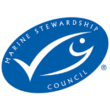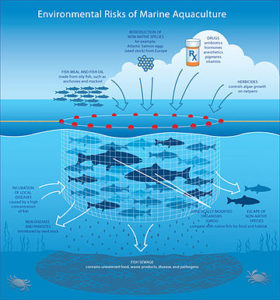Wild Salmon. Part 2

(This post is a continuation from last week on the subject of wild salmon.)
Among things I learned while on vacation in the PacNW recently-
- how wild salmon “inform” the growth of trees (Part 1 last week), and
- the danger of salmon farming on wild salmon
Mixing Farm-raised Salmon in Rivers and Streams Inhabited by Wild Salmon
 Erik told me that farm-raised salmon threaten the health of wild salmon. I sheepishly confessed that I thought farm-raised salmon come from large ponds in some place like Idaho (inland) rather than in the same rivers as those inhabited by wild salmon (coastal).
Erik told me that farm-raised salmon threaten the health of wild salmon. I sheepishly confessed that I thought farm-raised salmon come from large ponds in some place like Idaho (inland) rather than in the same rivers as those inhabited by wild salmon (coastal).
Nope.
Leaving aside these facts about what farm-raised salmon offer compared to wild salmon-
- more Omega-3 fatty acids (a good thing in moderation, according to the Cleveland Clinic)
- 20.5% more in saturated fats (a bad thing, same source)
- the question of cancer-causing antibiotic chemicals (to control sea lice, for instance) used in farm-raised Atlantic salmon (a/k/a aquaculture)
…there’s the matter of disease born to wild salmon by open-net pen salmon farming in PacNW rivers/streams and the Puget Sound–also in British Columbia and Norway.
For confusion avoidance, note that Atlantic salmon in the PacNW are derived from their eggs being transported from the Atlantic to fish farms on the West Coast. Most farm-raised salmon are of the Atlantic variety. Most wild salmon are among the 5 species of Pacific salmon.
 Open-net pens allow fish waste (including uneaten feed), antibiotics/other chemicals and farming byproducts to spread broadly from under-net into the wild of rivers and streams.
Open-net pens allow fish waste (including uneaten feed), antibiotics/other chemicals and farming byproducts to spread broadly from under-net into the wild of rivers and streams.
According to the Smithsonian, pathogens that could thrive in crowded pens can also escape to harm natural fish populations. WA Department of Health (WADH) has reported on this as well.
A particular disease threat called infectious salmon anemia is an influenza-like virus. It’s been found in a very minor portion of wild salmon populations, but there’s fear this disease may be adapted to a much larger scale. At least there are non-profits and higher-ed institutions watch-dogging this threat; but likely dependent on specific program funding/grants.
Sea lice is another occurrence in farm-raised Atlantic salmon. When reviewed on a monthly basis, if lice number more than 3 on any one fish, it’s supposed to be reported to designated government agencies. (Trust but verify.)
The good news for salmon lovers is offered by the WAPH for fish harvested from the PacNW: “…both wild and farmed salmon have low levels of mercury, PCBs, and other contaminants.” And, Omega-3 fatty acids are, of course, widely known to be heart-healthy.
 The bad news for salmon lovers is offered by SeaChoice, operated by the David Suzuki Foundation and partners. It claims unsustainable red-listed seafood includes salmon from Canada. So, if the sign at the seafood counter doesn’t say where the salmon comes from or shows a seal such as that of the Marine Stewardship Council (MSC), ask. If the clerk doesn’t know, consider buying some other kind of fish. Too, I dislike my fish meat being colored to look like something it isn’t–as is the case with farm-raised salmon.
The bad news for salmon lovers is offered by SeaChoice, operated by the David Suzuki Foundation and partners. It claims unsustainable red-listed seafood includes salmon from Canada. So, if the sign at the seafood counter doesn’t say where the salmon comes from or shows a seal such as that of the Marine Stewardship Council (MSC), ask. If the clerk doesn’t know, consider buying some other kind of fish. Too, I dislike my fish meat being colored to look like something it isn’t–as is the case with farm-raised salmon.
Just so you know–
There are closed containment fish farms which have barriers to control aquaculture and the natural environment. This method significantly reduces the concerns for the natural marine ecosystem noted above–and is a much more expensive way for producing corporate-scale fish harvests.
Manufacturers of feed stock have been improving formulation. The WADH advises: “New feeds are being developed with less fishmeal in them and more protein derived from grains and oilseeds, such as soybeans. Fish oil is also being partially replaced with plant-derived oils. In general, the more plant-based ingredients, the lower the level of long-chain omega-3 fats in the salmon. However, fish are fed feeds containing enough fish oil to maintain omega-3 fatty acid levels equivalent or higher than most wild fish.”
♠
Incidentally, 2 summers ago I blogged about sustainable seafood- “Even Wal-Mart is promoting its environmental credentials in the seafood aisle.” (also see In Sundry Dept.). One of my earliest posts, mentioned and linked chef Barton Seaver’s Ted Talk, “Sustainable Seafood? Let’s get smart.”